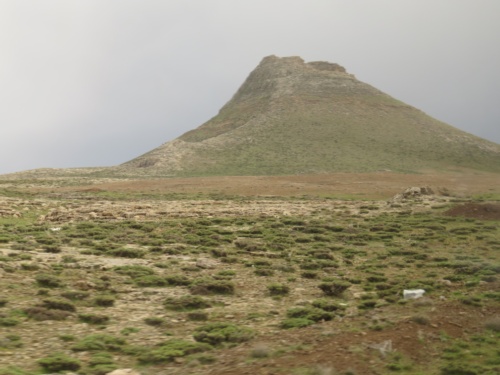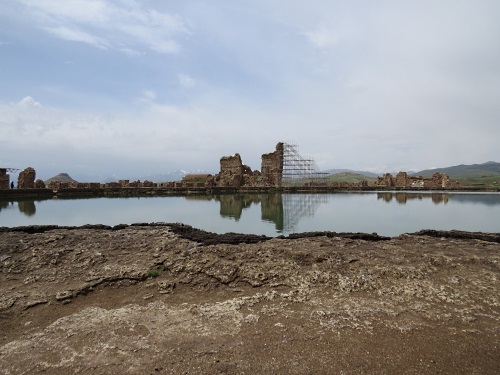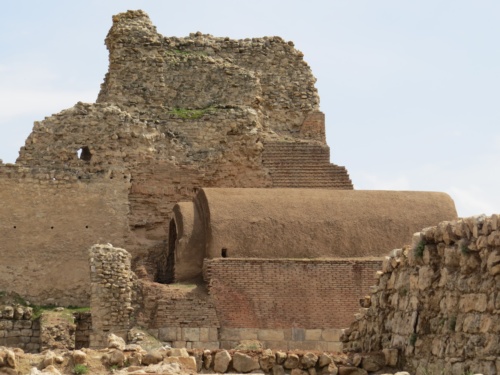Takht-e Soleyman is one of these names on the WH List that mean nothing unless you’ve been there. It ranked among the very lowest in our recent Community and Popular Votes for the
WHS Top 200, probably because almost nobody had visited it (13 were there before Solivagant and I visited in April/May 2016). It ended up being my favourite WHS of Northern Iran, both for its colourful mountain scenery and introduction to Zoroastrianism. We spent 3 hours there, but I could easily have stayed an hour more.
 |
| Solomon's Prison |
Takht-e-Soleyman (meaning: “the throne of Solomon”, an apocryphal name given during the Arab conquest) was the spiritual center of Zoroastrianism. It was created in the 6th century by the Persian Empire of the Sassanids, who were in fierce competition with the Byzantine Empire and Christianity and wanted to build a showcase for their own citizens.
Despite reading various sources beforehand and listening to the explanations of our tour guides, I find summarizing the faith of the Zoroastrians difficult. They worshipped one god, but in their temples the focus is on the four elements of water, earth, air and fire. The combined presence of a volcano (fire) and a natural spring (water) made Takht-e Soleyman an especially auspicious location for Zoroastrians.
After a nutritious lunch in the canteen of a nearby mine where we met two bewildered French tourists travelling with their own campervan, we started our visit at the volcano. This is nicknamed ‘Solomon’s Prison’ (Zendan-e Soleyman): folk tales suggest that King Solomon used to imprison monsters inside the 100 m deep crater. This small volcano can easily be climbed in 20 minutes or so, though it had previously been raining so I found the path to be quite slippery. And near the top you have to do some rock-climbing. Long ago Zoroastrian rituals were performed at this summit, but now it is mainly a natural spectacle: an empty, hollow volcano crater with a grass-field at the bottom.
 |
| The artesian lake at the main sanctuary |
The core zone of the WHS consists of several archaeological sites a few kilometers apart. The main sanctuary lies 2 kms away from the volcano. It is completely walled and resembles a fortress. A more than 60 meters deep lake is the surprising centerpiece. The water flows from here down the hill, and irrigates the surrounding agricultural land. It uses the ‘dragon wall’, a 2m high natural wall shaped by the sediments transferred alongside the water.
Our guide told that this sanctuary was especially made for the royals and the army of the Sassanids. Elsewhere in their state (for example near the Sasssanid capital Ctsesiphon in Iraq) there were spiritual centers for the general population. One of the most interesting buildings on the property is a long vaulted gallery, with an opening every few meters for a soldier to stand guard. It’s a bit of a mystery what the use of all these buildings was, and not all date from the original Sassanid construction (the later ‘Mongol’ Ilkhanid dynasty used the site also).
Photos in the on-site museum show that Zoroastrians still come here once a year, though the fire in the fire temple (a little square platform) has been extinguished long ago. After the Islamic Revolution of 1979, a lot of Zoroastrians have fled Iran. Their religion however is officially recognized, and I saw a
modern Zoroastrian temple in Teheran (it lies close to the St. Sergius Armenian Church, in the affluent north of the city).
 |
| Vaulted halls |
The fun isn’t over after you’ve left the core zone. My fellow travellers at this point in the trip had gotten the hang of spotting WHS signs, guessing possible OUV and debating conservation factors. Driving down from Takht-e Soleyman to Zanjan via the Dandi road, they were as amazed as I was by the long cableway that connects these mountains with the nearest town. Raw metals are transported this way. It must be worth of WH status as the ‘longest cable car traject in the world’! As icing on the cake we also were treated to a marvellous double
rainbow spanning the volcanic landscape. A fine finish to a great day in off-the-beaten track Iran.